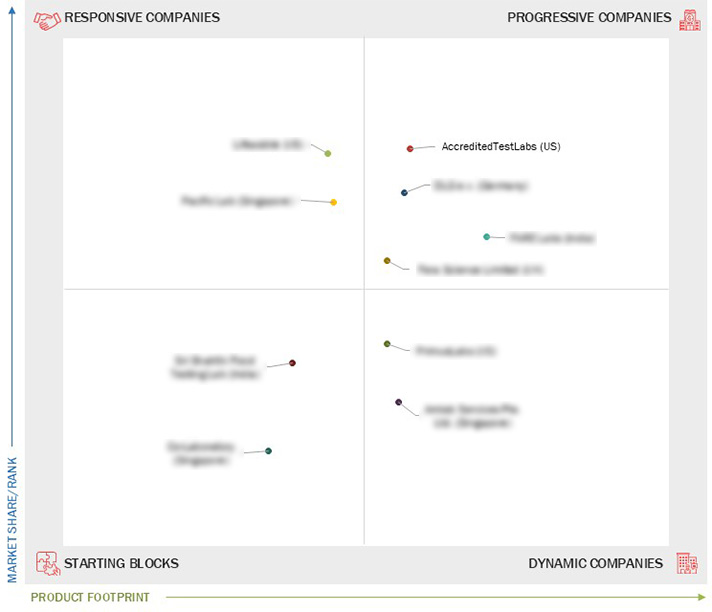Comparing 10 vendors in Juice Testing Startups across 0 criteria.
The juice testing market is critical for ensuring the quality, safety, and authenticity of fruit and vegetable juices. This market is driven by stringent food safety regulations and a growing consumer demand for high-quality, natural, and clean-label products. Testing is essential to verify label claims, detect contaminants like pesticides and heavy metals, identify adulteration, and ensure compliance with national and international standards. Advanced analytical techniques are increasingly being used to provide accurate and reliable results, helping manufacturers maintain brand reputation and consumer trust.
Market Leadership Quadrant
1.1 Study Objectives
1.2 Market Definition
1.3 Study Scope
1.3.1 Markets Covered and Regional Scope
1.3.2 Inclusions and Exclusions
1.3.3 Years Considered
1.4 Currency Considered
1.5 Unit Considered
1.6 Limitations
1.7 Stakeholders
2.1 Introduction
2.2 Market Dynamics
2.2.1 Drivers
2.2.1.1 Expansion of food & beverage industry
2.2.1.2 Global expansion of juice brands
2.2.1.3 The rising occurrence of juice recalls is driving the need of juice testing
2.2.2 Restraints
2.2.2.1 High cost of advanced testing
2.2.2.2 Growth of in-house juice testing
2.2.3 Opportunities
2.2.3.1 Increased contamination incidents drive opportunities in the juice testing market
2.2.3.2 Strict regulations are providing opportunities for juice testing
2.2.3.3 Expansion of testing services in emerging markets
2.2.4 Challenges
2.2.4.1 Lack of global standardized testing protocols
2.2.4.2 Time consuming procedures
2.3 Trends/Disruptions Impacting Customer Business
2.4 Value Chain Analysis
2.5 Ecosystem Analysis
2.6 Investment and Funding Scenario
2.7 Technology Analysis
2.7.1 Key Technologies
2.7.2 Complementary Technologies
2.7.3 Adjacent Technologies
2.8 Patent Analysis
2.9 Trade Analysis
2.10 Porter’s Five Forces Analysis
2.10.1 Threat of New Entrants
2.10.2 Threat of Substitutes
2.10.3 Bargaining Power of Suppliers
2.10.4 Bargaining Power of Buyers
2.10.5 Intensity of Competitive Rivalry
3.1 Introduction
3.2 Key Player Strategies/Right to Win
3.3 Revenue Analysis
3.4 Market Share Analysis
3.5 Company Valuation and Financial Metrics
3.6 Brand/Product Comparison
3.7 Company Evaluation Matrix: Startups/SMEs
3.7.1 Progressive Companies
3.7.2 Responsive Companies
3.7.3 Dynamic Companies
3.7.4 Starting Blocks
3.7.5 Competitive Benchmarking: Startups/SMEs
3.7.5.1 Detailed list of key startups/SMEs
3.7.5.2 Competitive benchmarking of key startups/SMEs
3.8 Competitive Scenario
3.8.1 Product/ Services Launches and Enhancements
3.8.2 Deals
3.8.3 Expansions
4.1 FARE Labs
4.1.1 Business overview
4.1.2 Products/Solutions/Services offered
4.1.3 Recent developments
4.2 AccreditedTestLabs
4.2.1 Business overview
4.2.2 Products/Solutions/Services offered
4.2.3 Recent developments
4.3 DLG e.v.
4.3.1 Business overview
4.3.2 Products/Solutions/Services offered
4.3.3 Recent developments
4.4 Fera Science Limited
4.4.1 Business overview
4.4.2 Products/Solutions/Services offered
4.4.3 Recent developments
4.5 Lifeasible
4.5.1 Business overview
4.5.2 Products/Solutions/Services offered
4.5.3 Recent developments
4.6 Pacific Lab
4.6.1 Business overview
4.6.2 Products/Solutions/Services offered
4.6.3 Recent developments
4.7 PrimusLabs
4.7.1 Business overview
4.7.2 Products/Solutions/Services offered
4.7.3 Recent developments
4.8 Amlab Services Pte. Ltd.
4.8.1 Business overview
4.8.2 Products/Solutions/Services offered
4.8.3 Recent developments
4.9 Sri Shakthi Food Testing Lab
4.9.1 Business overview
4.9.2 Products/Solutions/Services offered
4.9.3 Recent developments
4.10 Co-Laboratory
4.10.1 Business overview
4.10.2 Products/Solutions/Services offered
4.10.3 Recent developments



